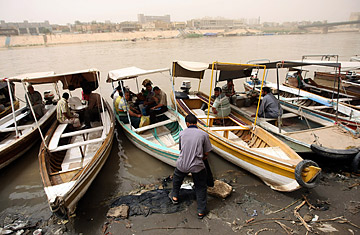
Iraqis take boats to cross the Tigris river from Baghdad.
Part 12 of TIME's Return to Baghdad series.
By 8 a.m. Friday, we were on the bank of the Tigris River, piling seven people into a small wooden boat that appeared to be made for three. As a budding journalist, I ascribe to the philosophy that I'll try pretty much anything once, but being larger than the average person, I also didn't want to sink our means of conveyance into the filthy water. To my relief, the boat proved hardy, and we made several swings up and down the river, taking in views of Baghdad's old city that few American soldiers ever get to see.
On the far bank, we climbed a steep set of stairs to the Mutanabbi market area and headed into a tight corridor between wind-blasted yellow-brick buildings. We ate breakfast at a well-known restaurant called Kubba Saray, a tiny, packed stall that in the U.S. would charitably be called a coffee stand. Our group huddled around a counter in the middle of the white-tiled room, and I found myself part of a crush of diners scarfing down kibbe, fried breading filled with meat. I didn't mind the crowd as much as the fact that my back was to the open door and windows, which led me to keep glancing over my shoulder to make sure there was a means of egress if I needed it. Some old habits never die.
After breakfast we walked across the street to the Shabender teahouse, a famous gathering place for Baghdad intellectuals in the era of Saddam Hussein. Brown columns and clusters of wooden benches arranged at right angles, resembling livestock pens, gave the room a cluttered but comfortable look. A few men in traditional dishdashas sipped tea near clusters of men in slacks and collared shirts and a group of teenagers in jeans and Converse Chuck Taylor sneakers. The place looked like a live, Technicolor version of Casablanca easing slowly into the 21st century.
Five framed portraits greeted the café's patrons from the wall facing the entrance. The neatly written Arabic under the pictures explained that the people in them ranged in age from 25 to 55. They were the owner's three sons, a brother and a nephew, and they were all killed when a massive bomb nearly leveled the place in March 2007.
Among the dozens of black-and-white pictures on the walls depicting Iraq's modern history was one color photograph of the café before the bombing. The columns were light blue then, the barstools dark navy. All the pictures were copies; the originals were vaporized in the explosion along with the five members of the owner's family.
Looking at the pictures, I thought back to battle update briefings, large meetings at which U.S. commanders received the day's intelligence reports before issuing orders for the following 24 hours. In such a meeting, this bombing would have been depicted as a red icon, indicating enemy activity, superimposed on a satellite image of narrow alleyways. There would be a brief description: 30 civilians killed and 65 wounded, with the main suspects being the Mahdi Army militia. The commander might have taken a minute to digest the information and perhaps consider how it would affect his mission before saying, "Next slide," and moving on to another distant tragedy.
Before heading out on the next mission, we would brief our soldiers, informing them that there had been another massive bombing in another sector of Baghdad. We wouldn't give them the details, because in our scheme of things, while some of the violence was intimate, most was unsettlingly interchangeable. Unless the bombing was in our sector, few troops would know that the explosion had demolished one of Baghdad's great institutions and killed five people so deeply connected to the place. All we needed to know to raid a house, hunt for roadside bombs or patrol a neighborhood was what could be found in the reports. There's much more, of course, to be found by walking the city.
